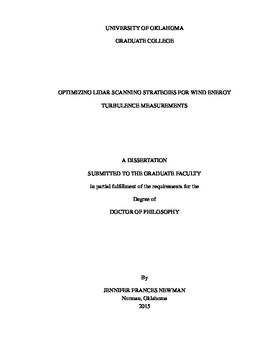| dc.description.abstract | Turbulence has a significant effect on wind farm power production and turbine reliability. Since remote sensing devices, such as lidars, are commonly used in wind energy studies, the accurate measurement of turbulence with lidars is an important research goal in the wind energy industry. However, several factors cause lidars to measure different values of turbulence than a sonic anemometer on a tower, including the use of a scanning circle with a diameter of ~100 m to estimate the three-dimensional wind field and the velocity variance contamination that can occur when a traditional Doppler-beam swinging (DBS) or velocity-azimuth display (VAD) strategy is used. In this work, several techniques for obtaining more accurate turbulence information from lidars were investigated.
One way to avoid the use of a scanning circle is to deploy multiple scanning lidars and point them toward the same volume in space to collect velocity measurements. If the lidar scans are synchronized, measurements from multiple lidars can be used to extract turbulence information. To test the ability of multi-lidar scanning strategies to measure mean wind speeds and turbulence, a lidar experiment was conducted in summer 2013 at the Southern Great Plains Atmospheric Radiation Measurement site. Two scanning strategies were tested -- the tri-Doppler technique, where three scanning lidars were pointed to approximately the same point in space, and the virtual tower technique, where the lidars were pointed at several different locations above the ground.
Another field campaign was conducted at the Boulder Atmospheric Observatory in Colorado to evaluate the ability of a new six-beam lidar scanning technique, which was designed to mitigate variance contamination, as well as the DBS and VAD techniques, to measure turbulence under different atmospheric stability conditions. Measurements from two vertically profiling lidars indicated that the choice of scanning angle has significant impacts on the measurement of the horizontal variance components. Large elevation angles increase the contribution of vertical velocity to radial wind speed measurements, which can increase the u and v variance if the vertical velocity field is not uniform across the lidar scanning circle.
Based on results from the two lidar campaigns, the vertical component of turbulence can be measured accurately by using a vertically pointed lidar beam position, but the horizontal components of lidar-measured turbulence are often inaccurate under unstable conditions as a result of variance contamination and horizontal heterogeneity across the lidar scanning circle. To improve lidar variance estimates under unstable conditions, two correction techniques were developed and tested on data from the field campaigns. Similarity theory was used to estimate the approximate ratio of the horizontal variance components to the vertical variance as a function of stability, which can then be used to calculate new values of the horizontal variance components, if an accurate measure of vertical variance has been obtained. Taylor's frozen turbulence hypothesis was used to estimate changes in the vertical velocity field across the lidar scanning circle, such that the contribution of vertical velocity to the horizontal velocity components could be taken into account. Both techniques reduced lidar variance estimates significantly and brought the estimates closer to variance estimated by sonic anemometers. | en_US |
